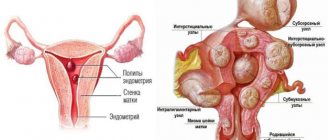Reasons for appearance
Menstrual bleeding actually contains some blood. During one regulation, about 40–100 ml are released, sometimes less. It flows out, mixing with the mucous secretion of the endometrium, cervical canal and vagina, carrying out the unfertilized egg and unnecessary functional membrane, cleansing the uterus. The discharge does not always retain a uniform bright red hue. Often women notice very dark, almost black clots. They may appear on the first day of menstruation, closer to its end, or acyclically. Sometimes black periods are repeated several cycles in a row. This picture is explained by the property of blood to quickly clot. Coming out of the vessels into the uterine cavity, it quickly darkens due to oxidizing iron. If clots of mucus and endometrium, soaked in blood, are not rejected immediately, but linger for a long time, then strange-looking dark masses are subsequently released. The main physiological reasons why periods can be black:
- Hormonal imbalances. During puberty and premenopause in women, the endocrine glands rearrange their work. The menstrual cycle “floats”, it can be delayed for several days or weeks, and critical days have different durations. This desynchronization contributes to the accumulation and thickening of bloody clots in the folds of the uterine cavity. A similar condition is also typical when taking hormonal contraceptives, when the ovaries begin to adapt to the rhythm dictated by the drug.
- Pregnancy. The process of conception and fetal development is often accompanied by pseudomenstruation - a small amount of mucus with blood that has a blackish tint is released from the genital tract.
- External provoking factors. Situations such as a sudden change in lifestyle, moving, severe physical or nervous stress, exhaustion inevitably affect the course of the cycle. In case of long delays, and sometimes with normal duration, menstruation begins with the release of black clots.
Pathological and conditionally pathological factors include everything associated with diseases or external interventions:
- Surgical operations, minimally invasive diagnostic methods, use of intrauterine devices. As a result of mechanical injuries to the epithelium of the genital organs, clots accumulate in the uterine cavity, coming out during its contractions.
- Endocrine systemic diseases.
- Inflammation and destructive processes occurring in the reproductive system.
Cause of spotting
Black discharge before (or after) menstruation never occurs without a reason. Main provoking factors:
- Hormonal imbalance.
- Psycho-emotional stress.
- Long-term use of antibiotics or oral contraceptives.
- Pregnancy.
- Pathology of the cervix (erosion).
- Endometritis (uterine endometriosis).
- Endometrial pathologies.
- Genital tuberculosis.
- Metabolic disorders in the body.
- Ectopic pregnancy or threatened miscarriage.
- Venereal or infectious diseases.
- Malignant tumor of the reproductive system.
- Postpartum period.
- Inflammation of the ovaries or uterus.
- Failure to follow healthy eating rules.
- Uterine hyperplasia.
- Erosion of the uterine cervix.
- Previous gynecological surgery.
The most common causes of black spotting after menstruation are pregnancy and the postpartum period. In this case, there is no need to panic, because dark vaginal discharge associated with pregnancy and childbirth is a normal physiological phenomenon.
If you have diseases and pathologies that provoked the manifestation of this symptom, you need to undergo a medical examination, after which the doctor will begin appropriate treatment. If it occurs as a result of an inflammatory process of the genitourinary system, the woman will experience an increase in body temperature and a nagging discomfort in the lower abdomen.
Hormonal imbalance as a factor that provokes darkening of the vaginal endometrium can be caused by physiological changes in the teenage body, menopause or diseases of the endocrine system.
If a woman’s menstrual cycle is regularly disrupted and dark clots are present in the blood, do not postpone a gynecological examination. Timely treatment of the disease that caused such discharge will help prevent complications.
Infections and inflammatory processes
Blackish clots in menstrual discharge are possible with the development of pathological processes in the uterine cavity and appendages. The presence of endometriosis, endometritis, fibroids, polyps, cysts, endometrial dysplasia lead to disruption of the timely separation and removal of the functional mucous layer to the outside.
Inflammatory diseases: endometrium, salpingitis, salpingoophoritis, parametritis and other pathologies become a consequence of hypothermia, complications of existing diseases of the pelvic organs. The risk of the formation of neoplasms and inflammation is always higher during the period of age-related hormonal changes, when the endocrine glands synthesize an insufficient amount of estrogens. Their deficiency leads to a decrease in local immunity, disturbances in peripheral blood supply, and a tendency to edema. Uncompensated diabetes mellitus leads to pronounced systemic disorders in the body, including causing inflammatory processes in the reproductive system.
One of the factors provoking black menstruation is medical and surgical abortion, diagnostic curettage. In all cases, harsh pharmacological or surgical intervention affects the balance of hormones and disrupts the fragile integrity of the mucous membranes. The consequences often include strictures and adhesions, which aggravate the pathology.
In addition to hormonal imbalances, sexually transmitted diseases remain an important cause of inflammatory processes in the genital organs. Among them:
- secondary and tertiary syphilis;
- gonorrhea;
- trichomoniasis;
- ureaplasmosis.
The presence of inflammatory and infectious diseases can be signaled by other symptoms besides dark clots:
- nagging pain in the lower abdomen, radiating to the lower back;
- pain, itching, burning in the vaginal area;
- redness, swelling, strange rashes in the perineum;
- low-grade or high fever;
- unpleasant putrid odor from cheesy discharge;
- profuse leucorrhoea outside of menstrual periods.
But additional symptoms that indicate pathological processes and the development of STDs are not always present.
What provokes
There are many reasons that cause black vaginal discharge:
- uterine polyposis;
- cysts;
- ectopic pregnancy;
- venereal diseases;
- inflammatory processes in the appendages, ovaries and other pelvic organs;
- oncopathology of the uterus;
- surgical interventions;
- intrauterine device.
Uterine polyposis is characterized by the formation of polyps on the walls of this organ, resulting in changes in the hormonal pattern and corresponding pathological discharge.
If you start to smear before your period, this is the first sign that timely diagnosis and proper treatment are required. With such a symptom, the formation of cysts cannot be ruled out.
When pregnancy develops outside the uterine cavity, the woman is unaware that fertilization has occurred. The resulting black discharge may be a consequence of internal bleeding, for example, when the fallopian tube ruptures. This condition poses a direct threat to the woman’s life and requires urgent hospitalization.
One of the main factors contributing to black discharge is sexually transmitted infections. Sexually transmitted diseases, which pose a serious threat to a woman’s health and also require a long and specific course of treatment, are very common. In this case, after dark discharge, menstruation begins with characteristic symptoms, manifested by itching of the genitals, discomfort during sexual intercourse, or acute pain in the lower abdomen. Such symptoms are characteristic, for example, of syphilis, gonorrhea and chlamydia.
Inflammatory processes in the appendages, ovaries and other pelvic organs can occur when an infection enters the genital tract or during oncological processes. In this case, discharge in women is accompanied by pain in the lower abdomen, severe itching and burning, and often a specific odor occurs. Immediate medical attention is required.
If the secreted vaginal secretion is black, this may indicate the presence of tumor formations in the uterus. In this case, any additional symptoms in the early stages are completely absent, and discharge is the only sign of pathology. To confirm or refute the diagnosis, you should consult a gynecologist and undergo the necessary examination.
Often, a black tint of discharge before menstruation can be observed due to certain surgical interventions: abortion, partial removal of the uterus or fibroids,
, curettage of the uterine cavity.
Using a contraceptive device can also cause dark discharge: improper installation of the device often causes infection in the vagina.
Black discharge before menstruation
Most often, dark discharge with clots that have accumulated near the cervical canal comes out at the beginning of menstruation. On the first day, the uterus begins to contract intensively, pushing them out. If this happened for the first time, and it was preceded by a cycle longer than usual, severe stress, hypothermia, exhausting stress, menstruation can be very heavy, and the clots do not come out for long - within a few hours or minutes, and their onset is preceded by a slight feeling of bloating and discomfort in the uterine area . Sometimes there is no painful sensation, just a few dark smears appear. In the case of a one-time appearance of such clots, physiology is usually to blame, but a regular pattern may indicate a violation of the integrity of the uterine cavity, leading to internal accumulations of blood.
Frequent black discharge before menstruation, usually a few days before its onset, signals possible endometriosis, hyperplasia or an infectious disease. There is also a possibility of hormonal imbalance. A typical picture is the beginning of scanty black spotting a week before menstruation. It is not necessary to have other symptoms.
Dark discharge before menstruation - what is it and when should you not worry?
You shouldn’t always panic and rush to see a gynecologist when you see a brown spot on a pad.
Situations when such a phenomenon does not require treatment:
- Formation of the cycle. Each organism is individual, and menarche (first menstrual bleeding) can occur in a young person at either 11 or 16 years of age. As a rule, a normal menstrual cycle is established within 1.5-2 years after this. During this time, the discharge may have a blackish tint, be smeared, linger, or even disappear for 1-2 months (if you have not had your period for more than 3 months, you need to contact a pediatric gynecologist). None of the above is a cause for concern.
- Use of combined oral contraceptives (COCs). When a woman uses a hormonal contraceptive for therapeutic purposes or to protect against an unwanted pregnancy, at the very beginning of taking the pills, her body needs some time to get used to the changes. Adaptation can be expressed in a delay in menstruation, the appearance of dark discharge before and after it, and sometimes in the middle of the cycle. Typically, such a side effect is prescribed in the instructions for the drug and is a variant of the norm.
- I recently started having sexual intercourse. No matter how simple modern morals may be, for many girls the first sexual experience in their life is a real event. Even if a girl loves her partner dearly, she experiences significant stress one way or another. And stress is known to affect hormonal levels. For this reason, the next period after the first night of love may change slightly, come earlier and appear as dark, spotting discharge.
- Sex. If a woman was not sufficiently aroused during intercourse and did not produce the required amount of lubricant, minor damage to the vaginal mucosa occurs. It is clear that the dark blood that appears in this case has nothing to do with menstruation and appears immediately after sex.
- Recent genital surgery. After surgery, the body will need some time to recover. The appearance of black discharge instead of menstruation during the first 2-3 cycles is not a pathology. Due to damage to the epithelium of the genital organs, clots accumulate in the uterine cavity, which come out during contractions of the muscular organ.
- Climate change. If you are flying from a hot summer to a harsh winter, or vice versa, you should not be surprised at a disruption in the menstrual cycle. After 1-2 months, your periods should return to normal.
- First menstruation after childbirth. In women who do not breastfeed, the uterus again begins to reject the endometrium approximately 1.5-2 months after delivery, and in nursing women - after 6-12 months. Although usually the first menstruation is characterized by profuseness, it can be quite the opposite - scanty dark, odorless discharge will remain on the pad, which can develop into a full-fledged menstruation, or end before it has really begun. However, if the spotting continues for more than 3 months, this is a reason to consult a specialist.
- Pregnancy. Approximately a week after successful conception, the fertilized egg attaches to the wall of the uterus. As a result, discharge may appear on the laundry, the color of which can vary from pink to dark brown. Do not be alarmed; the appearance of such discharge is a fairly clear sign of pregnancy. However, be careful, too much bleeding may indicate a threat of miscarriage or detachment.
In addition to the above phenomena, the appearance of dark discharge for some women may be the norm 1-2 before the start of menstruation (spotting is a harbinger of discharge and indicates that full menstruation will soon begin), or within 1-2 after it (with a light cycle, the uterus releases residual menstrual blood).
After or during ovulation
During menstruation, the internal microflora changes, the number of conditional pathogens increases, and the reproductive system becomes especially vulnerable to pathogens. Black discharge after menstruation (in the last days or a few days after the end of the period) is often observed in infectious and inflammatory diseases. This is confirmed by the presence of itching, burning inside, pain during urination, and nagging pain.
In some cases, dark discharge a week after menstruation is the result of severe stress, hypothermia or heavy physical activity.
In some women, individual physiological characteristics make it possible to determine the time of ovulation using some signs with an accuracy of several hours. They feel unwell: they feel dizzy, the temperature may rise, after a few days, already in the second half or at the end of the cycle, there is a black discharge, usually very scanty, in the amount of several strokes.
Yellow vaginal discharge with odor
Vaginal discharge with a strong and unusual odor may indicate an infection
Yellow vaginal discharge with a strong odor usually indicates an infection. This could be anything from bacterial vaginosis to sexually transmitted diseases (STDs). An example of an STD that causes yellow vaginal discharge is trichomoniasis.
Millions of people around the world have trichomoniasis, but only 30% of them develop symptoms, which include the following:
- discharge with an unusual fishy odor;
- sensitivity, itching, redness and burning;
- an increase in vaginal discharge, which may be yellowish, but also white, clear or green.
- discomfort during sexual intercourse.
When a woman suspects that she is infected with trichomoniasis, she should consult a doctor. If trichomoniasis is left untreated, it can bother a person for several months or even years.
Instead of menstruation - black discharge
In addition to dark discharge in the middle or end of the cycle, which causes many changes in a woman’s body, there are situations when the appearance of menstruation completely changes in this way.
Black discharge instead of menstruation is possible after surgery. Many massive blood clots could remain inside the uterine cavity, which had time to clear and become dark. When the next regula occurs, dissolved by mucus, they color it black. Their intensity is higher than usual.
Taking oral hormonal contraceptives almost always causes scanty black discharge instead of menstruation, signaling the “tuning” of the ovaries. The functional endometrium in these cases is formed much thinner and little mucus comes out. With postcoital contraception, such acyclic menstruation can occur over several cycles.
Abundant dark discharge with a strong unusual odor, an admixture of pus, accompanied by pain and other unfavorable symptoms, repeated repeatedly, may be a sign of cancer or severe inflammation.
Or sick
The following signs will indicate an infectious nature or inflammation (for example, as a result of hypothermia): itching, swelling, burning, unpleasant odor, rash on the genitals.
Let's look at what diseases may be manifested by discharge with a yellowish tint. And you check with your observations and feelings. But don’t diagnose yourself, much less prescribe treatment. I am giving you information for general information so that you do not guess, but when going to the gynecologist, you know approximately what to expect. Cervical erosion. Scanty yellowish discharge, often with blood streaks or pinkish patches.
Adnexitis. Yellow purulent discharge with a characteristic odor; in chronic adnexitis, it is more scanty, but is accompanied by visible irritation.
Chlamydia. Itching when urinating and not only, pain during sex. The discharge, as with adnexitis, is yellowish and purulent.
Salpingitis. Copious discharge, sexual intercourse with pain and the appearance of pinkish mucus after it. During menstruation, the stomach hurts greatly and appetite decreases.
Trichomoniasis. Greenish tint, may bubble a little. The smell of rotten fish is characteristic. Redness and severe itching are noticeable on the external genitalia.
Gonorrhea. Almost the same symptoms as with trichomoniasis: itching, burning, irritation, “greenness”. Possible delay of menstruation.
Allergy. Apart from a yellowish tint and slight irritation or rash, nothing to worry about.
Black discharge during pregnancy
The process of implantation of the zygote in the endometrium is sometimes accompanied by characteristic dark clots emerging from the genital tract. This phenomenon is quite rare, so it is sometimes mistaken by women for a hormonal imbalance or an early warning sign of menstruation. Often the consolidation of the embryo is accompanied by other signs: the breasts swell, the nipples become sensitive, and body weight increases. Black discharge during pregnancy lasts 2-3 days, and it is quite scanty. The time of their appearance is the expected ovulation or a few days after it. The appearance of a subsequent delay more clearly indicates conception. Implantation dark discharge during pregnancy can occur more than once with an interval of several days or weeks, which is explained by the structural features of the endometrium in each woman.
When dark discharge appears, a dangerous condition such as an ectopic pregnancy cannot be ruled out. In this case, the pathology is accompanied by shooting pains in the abdominal cavity and coccyx.
After childbirth, during the process of cleansing and contraction of the uterus, the so-called lochia containing many dark clots emerge from the woman for 5–7 weeks. The return of the menstrual cycle during or after lactation is also associated with accumulations of dark clots and their delayed elimination.
Doctors' recommendations
It can be quite difficult to independently understand why dark discharge with clots occurs between or during menstruation. The surest way to relieve all concerns is to contact an antenatal clinic. A doctor’s help may be urgently needed, since with serious pathological processes in the uterus, the situation can result in massive bleeding before menstruation.
Changes in hormonal levels and other reasons that lead to the appearance of atypical discharge can also be dangerous to health and life. The risk is especially high with a simultaneous sharp decrease in blood pressure, pain, and dizziness. Delay in such cases is highly undesirable.











